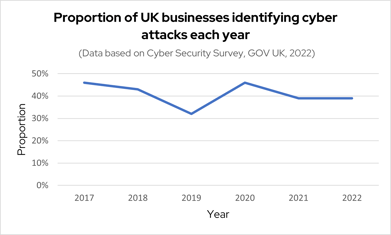The primary goal of cyber security is to protect a business's IT infrastructure from the ever-growing threat landscape and to ensure the confidentiality, integrity, and availability of data and systems.
With continuous technology advancements across the IT industry, unfortunately, the same advancements are also expected when it comes to cyber-attacks and the evolutions in malicious intent, hacks, ransomware and data breaches. But, to pre-empt and counter them, the same evolutions are occurring within cyber security services.
Graph showing cyber attack data taken from UK GOV Cyber Security Breaches Survey 2022
Let’s take a look at some predictions for the latest cyber security trends in 2023.








